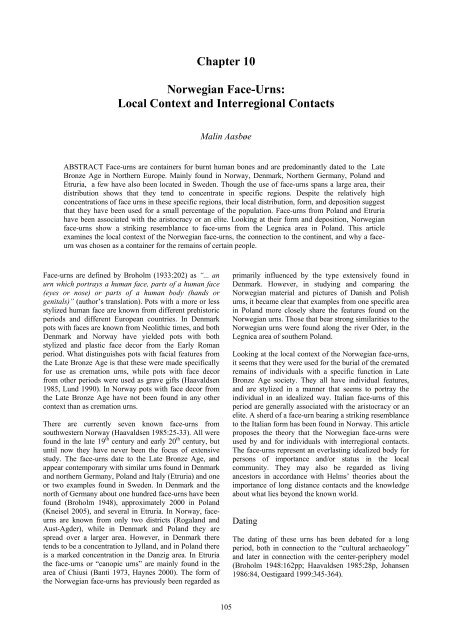The Materiality of Death - mikroarkeologi.se
The Materiality of Death - mikroarkeologi.se
The Materiality of Death - mikroarkeologi.se
Create successful ePaper yourself
Turn your PDF publications into a flip-book with our unique Google optimized e-Paper software.
Chapter 10<br />
Norwegian Face-Urns:<br />
Local Context and Interregional Contacts<br />
Malin Aasbøe<br />
ABSTRACT Face-urns are containers for burnt human bones and are predominantly dated to the Late<br />
Bronze Age in Northern Europe. Mainly found in Norway, Denmark, Northern Germany, Poland and<br />
Etruria, a few have also been located in Sweden. Though the u<strong>se</strong> <strong>of</strong> face-urns spans a large area, their<br />
distribution shows that they tend to concentrate in specific regions. Despite the relatively high<br />
concentrations <strong>of</strong> face urns in the<strong>se</strong> specific regions, their local distribution, form, and deposition suggest<br />
that they have been u<strong>se</strong>d for a small percentage <strong>of</strong> the population. Face-urns from Poland and Etruria<br />
have been associated with the aristocracy or an elite. Looking at their form and deposition, Norwegian<br />
face-urns show a striking re<strong>se</strong>mblance to face-urns from the Legnica area in Poland. This article<br />
examines the local context <strong>of</strong> the Norwegian face-urns, the connection to the continent, and why a faceurn<br />
was cho<strong>se</strong>n as a container for the remains <strong>of</strong> certain people.<br />
Face-urns are defined by Broholm (1933:202) as “... an<br />
urn which portrays a human face, parts <strong>of</strong> a human face<br />
(eyes or no<strong>se</strong>) or parts <strong>of</strong> a human body (hands or<br />
genitals)” (author’s translation). Pots with a more or less<br />
stylized human face are known from different prehistoric<br />
periods and different European countries. In Denmark<br />
pots with faces are known from Neolithic times, and both<br />
Denmark and Norway have yielded pots with both<br />
stylized and plastic face decor from the Early Roman<br />
period. What distinguishes pots with facial features from<br />
the Late Bronze Age is that the<strong>se</strong> were made specifically<br />
for u<strong>se</strong> as cremation urns, while pots with face decor<br />
from other periods were u<strong>se</strong>d as grave gifts (Haavald<strong>se</strong>n<br />
1985, Lund 1990). In Norway pots with face decor from<br />
the Late Bronze Age have not been found in any other<br />
context than as cremation urns.<br />
<strong>The</strong>re are currently <strong>se</strong>ven known face-urns from<br />
southwestern Norway (Haavald<strong>se</strong>n 1985:25-33). All were<br />
found in the late 19 th century and early 20 th century, but<br />
until now they have never been the focus <strong>of</strong> extensive<br />
study. <strong>The</strong> face-urns date to the Late Bronze Age, and<br />
appear contemporary with similar urns found in Denmark<br />
and northern Germany, Poland and Italy (Etruria) and one<br />
or two examples found in Sweden. In Denmark and the<br />
north <strong>of</strong> Germany about one hundred face-urns have been<br />
found (Broholm 1948), approximately 2000 in Poland<br />
(Knei<strong>se</strong>l 2005), and <strong>se</strong>veral in Etruria. In Norway, faceurns<br />
are known from only two districts (Rogaland and<br />
Aust-Agder), while in Denmark and Poland they are<br />
spread over a larger area. However, in Denmark there<br />
tends to be a concentration to Jylland, and in Poland there<br />
is a marked concentration in the Danzig area. In Etruria<br />
the face-urns or “canopic urns” are mainly found in the<br />
area <strong>of</strong> Chiusi (Banti 1973, Haynes 2000). <strong>The</strong> form <strong>of</strong><br />
the Norwegian face-urns has previously been regarded as<br />
primarily influenced by the type extensively found in<br />
Denmark. However, in studying and comparing the<br />
Norwegian material and pictures <strong>of</strong> Danish and Polish<br />
urns, it became clear that examples from one specific area<br />
in Poland more clo<strong>se</strong>ly share the features found on the<br />
Norwegian urns. Tho<strong>se</strong> that bear strong similarities to the<br />
Norwegian urns were found along the river Oder, in the<br />
Legnica area <strong>of</strong> southern Poland.<br />
Looking at the local context <strong>of</strong> the Norwegian face-urns,<br />
it <strong>se</strong>ems that they were u<strong>se</strong>d for the burial <strong>of</strong> the cremated<br />
remains <strong>of</strong> individuals with a specific function in Late<br />
Bronze Age society. <strong>The</strong>y all have individual features,<br />
and are stylized in a manner that <strong>se</strong>ems to portray the<br />
individual in an idealized way. Italian face-urns <strong>of</strong> this<br />
period are generally associated with the aristocracy or an<br />
elite. A sherd <strong>of</strong> a face-urn bearing a striking re<strong>se</strong>mblance<br />
to the Italian form has been found in Norway. This article<br />
propo<strong>se</strong>s the theory that the Norwegian face-urns were<br />
u<strong>se</strong>d by and for individuals with interregional contacts.<br />
<strong>The</strong> face-urns repre<strong>se</strong>nt an everlasting idealized body for<br />
persons <strong>of</strong> importance and/or status in the local<br />
community. <strong>The</strong>y may also be regarded as living<br />
ancestors in accordance with Helms’ theories about the<br />
importance <strong>of</strong> long distance contacts and the knowledge<br />
about what lies beyond the known world.<br />
Dating<br />
<strong>The</strong> dating <strong>of</strong> the<strong>se</strong> urns has been debated for a long<br />
period, both in connection to the “cultural archaeology”<br />
and later in connection with the center-periphery model<br />
(Broholm 1948:162pp; Haavald<strong>se</strong>n 1985:28p, Johan<strong>se</strong>n<br />
1986:84, Oestigaard 1999:345-364).<br />
105
















